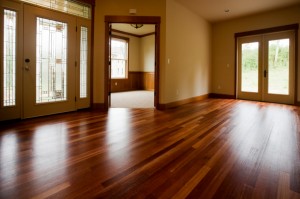
Wood has been a material well used by humans since humans were humans. You might assume that the use of such a natural material is on the decrease, being edged out by manufactured solutions such as laminates; however, you’d be wrong.
The best modern aesthetic is often that which doesn’t turn its back on nature entirely, rather it includes the natural as one of its dimensions. Modern homes might contain plant life or might use wooden furnishings for a homely and beautiful aesthetic.
Solid wood flooring is not just used popularly because of its unbeatable aesthetics, but it is also used because of its functionality. To say the least, a quality wood floor feels great to walk on. It will also be something built to last and hardwood flooring can persist for many years with minimal care, even in areas of heavy footfall, such as family homes.
When we say minimal care we don’t necessarily mean no care at all. Actually, your wood floor will enjoy the longest life if you do care for it occasionally. Remember, wood is a living material and continues to have a life even when used as flooring. The way you nurture this life makes all the difference.
With this in mind, here are some tips for ensuring the long life and quality of your hardwood floor:
By all means, clean your hardwood floor, however, you shouldn’t just clean it any old way. Certain harsh chemical cleaners can actively harm the surface of a wooden floor. These, then, are best avoided. Instead, you should clean your floors with a very mild soap and water solution.
You don’t need to do this all too often. Instead, you can clean a floor simply by dry cleaning any spillages when they occur. Whilst most wooden floors are treated so that they are protected against the mal-effects of water, water damage is still a very real possibility. You can safeguard against this by cleaning up spillages as soon as they occur and ensuring your wood floors aren’t exposed to condensation etc.
Wooden floors can be seriously damaged through physical activity. By physical activity, we’re usually talking about footfall. In areas of heavy footfall, e.g.
family homes, you’ll need to ensure that physical contact between shoes and surface is kept to a minimum, especially when we’re talking about heeled shoes.
Similarly, you can protect your floors by covering the ends of things like furniture legs. The regular movement of furniture can create scratches in the finish of a wood floor which can ostensibly undermine the quality of the overall aesthetic.
If your floor is showing signs of wear and tear, you could get it repaired, re-finished or polished; however, as we all know prevention is better than cure.
